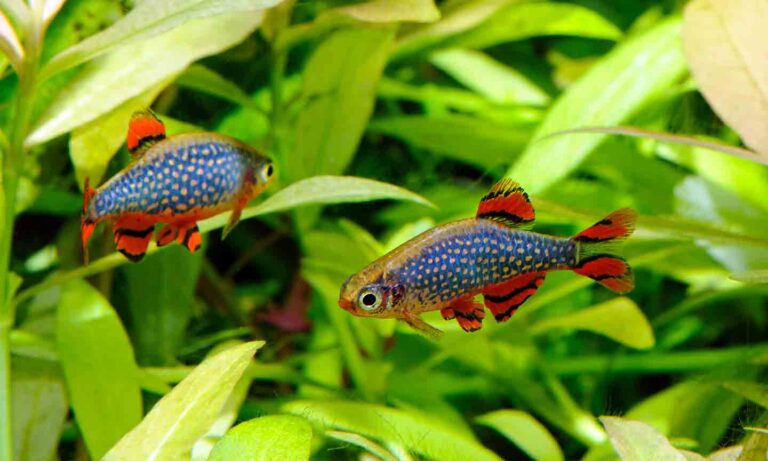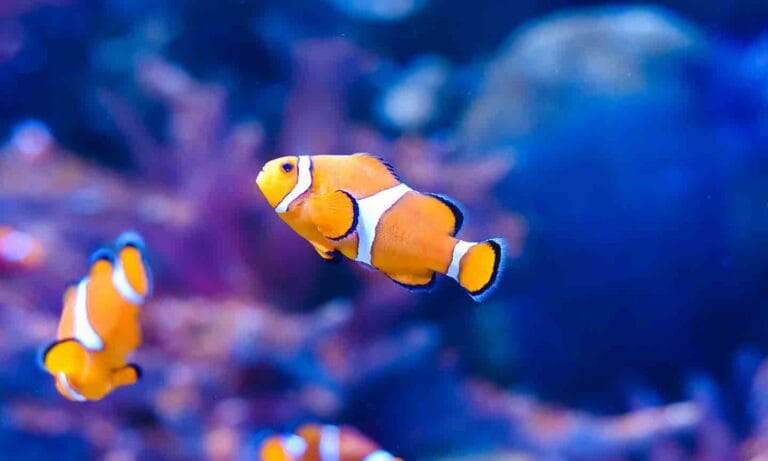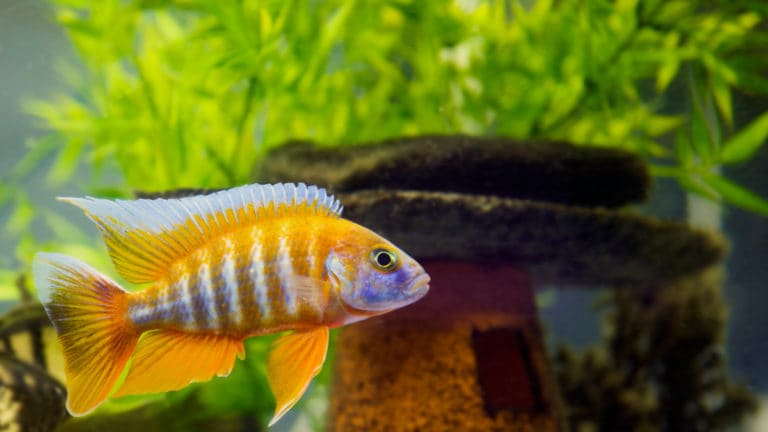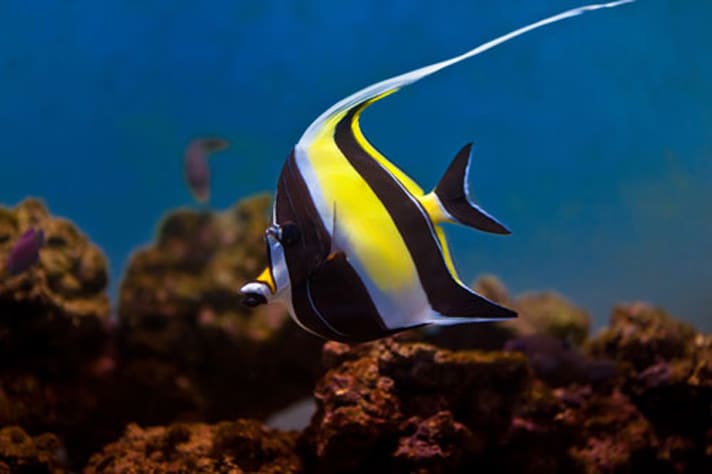Wild male dwarf gourami is an astoundingly beautiful fish. The deep-bodied, laterally compressed male can reach a size of about 2.5 inches, with the female staying a little smaller. The wild form of the male has a metallic turquoise blue face and body, with a dozen or more bright orangey-red vertical stripes transecting the body from behind the gills and extending into the long-based dorsal and anal fins, as well as into the tail fin. The attractive female fish, on the other hand, is not nearly as colorful as the male, being a pale silvery-blue with a faint trace of orange-yellow vertical stripes from behind the gills.
Manmade strains of dwarf gouramis are available, in which the male fish is predominantly blue or red, giving rise to the powder blue, neon blue and the red or sunset forms of the dwarf gourami. The female fish of all these varieties are much the same: a pale blue. It’s therefore important to buy a male and female from the same source, particularly if they are going to be used as breeding stock.
The dwarf gourami (Colisa lalia), belongs to the family Belontiidae and has a labyrinth organ that allows it to utilize oxygen from air gulped at the surface. The labyrinth organ contains a maze of lamellae that are well-supplied with blood vessels that absorb oxygen, enabling the gourami to live in water that has low levels of dissolved oxygen. Another peculiarity common to gouramis is the long feelerlike pelvic fins used to touch things and even to greet other gouramis. These long pelvic fins are also reputed to have taste cells.
Today all dwarf gouramis reaching the aquatic hobby are bred at fish farms in southeast Asia. When buying these fish, take time to observe them to ensure they are healthy and swimming well. Healthy males will always be sparring or observing other males in their vicinity. Make sure the fish you select do not have any ulcers on their bodies and that the fins, including the long feelers, are all intact.
It’s easy to tell the colorful male from the smaller, plumper female. Additionally, the male’s dorsal fin is slightly longer and more tapered, compared to the rounder tip on the female. So, picking a male and female pair should be relatively easy.
Dwarf Gourami Tanks
When breeding the dwarf gourami, hobbyists need more than one fish aquarium. The first aquarium is needed to hold the adult parent fish when they are not breeding (this aquarium can be a community tank). Another smaller aquarium could double up as the breeding aquarium, as well as the grow-out aquarium.
Dwarf gouramis are generally peaceful fish ideal for a community tank containing other small, equally peaceful fish. For this purpose, a medium-sized planted aquarium (36 by 18 by 18 inches, 50 gallons) would be ideal. A whole range of plants are suitable for this tank, with shorter plants for the foreground and taller plants, such as Cabomba caroliniana or Limnophila aquatica, for the back and sides of the tank. These are fast-growing, and three or four strands can be allowed to drape on the water surface, which male dwarf gouramis like because they can anchor their bubblenests there. For plants to do well, a substrate of 2 to 3 inches of small-sized gravel will do, though laterite is better for plant growth. Lighting from florescent tubes in the aquarium hood should provide at least 15 to 20 watts per square foot.
Dwarf gouramis originally come from water that is slightly acidic to neutral and relatively soft (pH 6.0 to 7.0; dH 4 to10), which is what is used to raise the farm-bred fish. The gouramis will, however, adapt to other water conditions. The water should be of high quality, which requires the use of an adequate filtration system. Water temperature needs to be in the range of 75 to 78 degrees Fahrenheit. Water changes of 20 percent every two weeks will help maintain good water quality.
There are many fish from southeast Asia that are small and peaceful, and would make good additions to a community tank containing a pair of dwarf gouramis. The delicate threadlike pelvic fins of the gouramis could be a focus for fin-nippers, such as tiger barbs, but there are a lot of gentler barbs. Cherry barbs need to be kept in a shoal, as do danios (such as zebra or leopard danios), and these are a nice contrast in color to the barbs. For the substrate, a group of small loaches would do nicely. Other suitable fish include rasboras, tetras, platies and Corydoras.
In the aquarium, dwarf gouramis and other fish in this community are not fussy eaters; they will eagerly eat flakes and do relatively well on them. However, all fish like feeding on live foods or their frozen equivalents, which are readily available these days. Frozen bloodworms are quickly consumed, as are live whiteworms, Daphnia and mosquito larvae — which are a good way to bring fish into breeding condition.
Breeding the Dwarf Gourami
In the community aquarium, healthy, mature male and female dwarf gouramis will usually spawn — but fry are unlikely to survive there. To raise gourami fry, get a separate spawning/breeding tank. This tank could be perhaps a bit smaller than the display tank (24 by 12 by 16 inches, 20 gallons), without substrate on the bottom but with some floating Cabomba at the water surface. On the bottom, a few small clay pots laid on their sides will provide hiding places for the female, should she need to escape the attention of an overzealous male. Water conditions should be similar to that of the community tank. But water levels can be dropped to about the two-thirds so it is easier for the male to pick up the fallen eggs and bring them back to the bubblenest. Temperatures should be around 78 to 80 degrees. Filtration for the breeding tank is best provided by a mature air-driven sponge filter.
The female dwarf gourami can be introduced to this tank on her own. Here, she should be fed on a diet rich in live food for a period of seven to 10 days, so she fills up with roe. At the same time, several jars of infusoria culture to feed very tiny fry are started with a crushed lettuce leaf in each jar of water placed on a sunny window sill. Another good culture to get going is microworms; start by obtaining a starter culture from any keen fish breeder, your aquarium club or by mail order. Microworms make an ideal second food for the fry as they grow, as do newly hatched brine shrimp nauplii hatched in saltwater from decapsulated brine shrimp eggs.
Seven to 10 days after putting the female into the breeding tank, the male dwarf gourami can be introduced. Within a day or so, he should build a nest made of mucous-coated air bubbles anchored to the overhanging plants at the water’s surface. At the same time, he will court the female by flaring his fins and showing his brightest colors. Often there will be some chasing, at which time the female might need the cover of the pots to hide in. When ready to spawn, the female approaches the male and spawning takes place under the nest.
During spawning, the male wraps his body around the female and turns her on her back, at which time eggs and sperm are released. They break from the spawning embrace, and the male gathers the floating eggs and places them in his bubblenest. The spawning embrace is repeated time and again over the next hour or so until the female has released all her eggs. She is then chased from the scene, as the male takes full responsibility of caring for the eggs and fry. This is a good time to move the female back to the community aquarium carefully, without disturbing the nest and eggs too much. The water level should also be dropped to about 6 inches; the reduced volume of water makes it easier for the tiny gourami fry to find food.
The male guards the eggs in the nest, which should start to hatch some 24 hours later. The tiny, almost invisible fry continue to develop, occasionally falling out of the nest, to be promptly picked up by the male and returned to it. By day three, the fry are free-swimming and begin to disperse in spite of the best efforts of the male. At this stage, the male gourami should be returned to the community tank.
Another way of managing this project is to allow the dwarf gourami pair to spawn in the community tank. A day or so after the spawning, when the male is looking after the eggs in the bubblenest, the nest with eggs can be removed to the grow-out tank that contains identical water to that in the community tank, leaving the adult gouramis behind. This is easily done by carefully sliding a bowl under the nest and gently lifting the nest intact and then carefully releasing it at the water’s surface of the grow-out tank.
Moving and Culling
To achieve the best results breeding dwarf gouramis, the number of fish should be reduced by at least 50 percent by moving half the young fish to another tank or alternatively culling them by feeding them to the fish in the community tank. This is what happens all the time in nature, with just a few fish surviving to adulthood. It’s necessary to provide growing fish with adequate space in good-quality water with sufficient food to turn out high-quality fish. There is absolutely no point in turning out hundreds of stunted runts. By the time they are 4 weeks old, it is probably best to have culled again and work with just 30 to 40 young fish to get quality results with just one grow-out tank.
Growing Out the Fry
Once free-swimming, the fry start to feed on foods small enough to fit into their tiny mouths. The best foods at this stage are live foods that are not likely to pollute the water. This is where the previously set-up infusoria cultures are used. A tablespoon of the infusoria culture should be added to the fry tank several times a day. Alternatively, liquid fry food for egglayers could be used sparingly as not to pollute the water. Small daily water changes done with care should be started using an air line covered in muslin fabric to siphon out the water but not the fry.
Assuming the fry have been receiving plenty of tiny food, some six or seven days after becoming free-swimming, they should have grown enough to start tackling microworms, which can be included in the feeding regimen while keeping the infusoria feeding going. Newly hatched brine shrimp nauplii can also be added to the diet. As the gourami fry grow, they can be weaned onto crushed flake foods that are fed sparingly (to not pollute the water). At this stage, the water level in the tank can be increased over a few days to fill the aquarium. In spite of this added volume of water, the tank will soon be crowded with hundreds of young, growing fish.
Dwarf gouramis are beautiful, generally robust fish that are relatively easy to keep and can live for four years. They have interesting breeding habits in which the male looks after the eggs and developing fry. They do make for a satisfying breeding project that can be easily managed.
By: Iggy Tavares
Featured Image: Mirko Rosenau/Shutterstock
Fish Breeding
Share:










